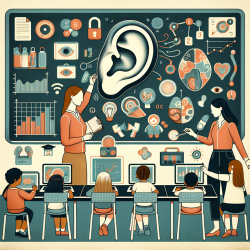As a practitioner in the field of special education, staying updated with the latest research can significantly enhance your practice. One such crucial area is the early detection and management of deafness in very young children. The research paper titled "Screening and Epidemiology of Deafness in Very Young Children" by Menegaux, Helias, and Lafon provides valuable insights into systematic screening and its importance. This blog will guide you on how to implement these findings in your practice effectively.
Key Findings from the Research
The study, conducted between 1969 and 1975, systematically tested 10,270 newborns and found a yield of 13 cases of hearing loss, translating to 1 in 750 live births. The results highlighted several critical points:
- Approximately one case of deafness per 1,000 births.
- The importance of systematic screening for early detection.
- Only 5% of deafness cases had no precise etiology.
- Systematic screening should be part of standard neonatal and postnatal examinations.
Implementing Research Outcomes in Your Practice
Based on these findings, here are some actionable steps you can take to enhance your practice:
1. Incorporate Systematic Screening
Ensure that systematic screening for hearing loss is part of your standard neonatal and postnatal examination protocols. This can help in early identification and intervention, which is crucial for the child's development.
2. Utilize Advanced Screening Equipment
The study used the VEIT-BIZAGUET audiometer, which provides various signals for testing. Incorporating advanced screening equipment in your practice can improve the accuracy of your screenings.
3. Focus on High-Risk Populations
Pay special attention to high-risk newborns, such as those with a family history of deafness or those born prematurely. Early and frequent screenings for these populations can lead to better outcomes.
4. Educate and Train Staff
Training your staff on the importance of early screening and how to use advanced equipment can significantly enhance your practice. Ensure they understand the different types of motor reactions to auditory stimuli and how to interpret them accurately.
5. Encourage Follow-Up Examinations
Follow-up examinations are crucial, especially for newborns who show signs of hearing loss. The study found that some cases of deafness were not present at birth but developed within the first year. Regular follow-ups can help in timely intervention.
Encouraging Further Research
While the study provides a solid foundation, continuous research is essential for improving early detection and intervention strategies. Encourage your team to stay updated with the latest research and consider participating in or conducting studies to contribute to the field.
To read the original research paper, please follow this link: Screening and Epidemiology of Deafness in Very Young Children.










